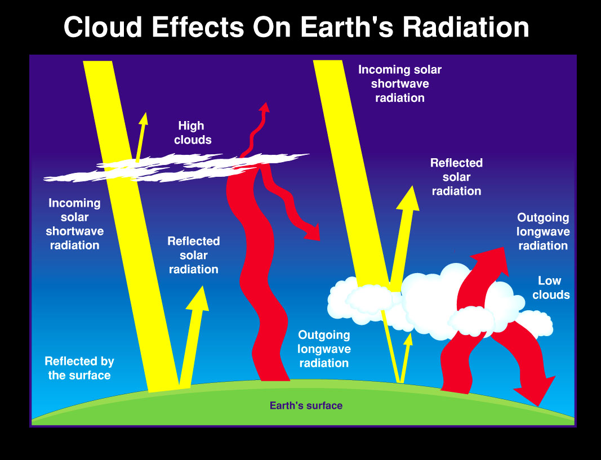
This graphic demonstrates how clouds affect the heating and cooling of the Earth. In general, high clouds hold-in heat from the Sun and warm the planet, while Earth is cooled when low clouds reflect sunlight back into Outer Space. (Graphic Sources: NASA, Zooniverse.org)
By Glenn A. Walsh
Reporting for SpaceWatchtower
A new Citizen Science project will help NASA scientists identify cloud types, cloud cover, and how blue the sky is at a given time. From the review of sky photographs on-line, Citizen Scientists will help NASA determine how clouds affect the Earth's climate.
The NASA Globe Cloud Gaze (i.e. Community science project Leveraging Online and User Data through GLOBE And Zooniverse Engagement) community science project utilizes photographs taken by GLOBE Citizen Scientists (through the Zooniverse Citizen Science Portal), and then compares Citizen Scientists' descriptions of these photographs with satellite data collected by NASA. NASA scientists expect this will help them map energy flows across the planet and show how clouds influence this flow of energy.
The height of clouds, and the amount of moisture they contain, determine whether the particular cloud helps to warm Earth or cool the planet. In general, high clouds tend to have a warming effect on the planet, as they block infra-red radiation from escaping back into Outer Space after being received from the Sun. While, in general, low clouds tend to have a cooling effect on the planet, as they reflect more sunlight back into Outer Space. (See graphic at the beginning of this blog-post.)
For sky color, scientists are studying the effects of other sky phenomena such as contrails, dust, haze, smoke, and smog. They hope to determine how much this additional sky phenomena affects the heating and cooling of the planet.
You can help NASA with this project by participating in one or more of the three lines of study:
Cloud Cover - Focuses on how much each photograph is covered by clouds.
What Do You See? - Focuses on which cloud types or other sky events (e.g. dust storm or smoke plumes) you observe in the photographs.
Sky Color – Focuses on what is the deepest blue you see in each photograph.
Link >>> https://www.zooniverse.org/projects/nasaglobe/nasa-globe-cloud-gaze
Internet Links to Additional Information ---
Citizen Science Projects: Link >>> https://buhlplanetarium2.tripod.com/FAQ/citizenscience.html
Zooniverse Citizen Science Portal: Link >>> https://www.zooniverse.org/
NASA: Link >>> https://www.nasa.gov/
Science Friday Public Radio Program: Link >>> https://www.sciencefriday.com
Related Blog-Post ---
"Science Experiments Children & Teens Can Do At Home !" Tue., 2018 June 5.
Link >>> https://spacewatchtower.blogspot.com/2018/06/science-experiments-children-teens-can.html
Source:
Glenn A. Walsh Reporting for SpaceWatchtower,
a project of Friends
of the Zeiss.
Monday, 2021 August 23.
Like This Post? Please
Share!
More
Astronomy & Science News - SpaceWatchtower Twitter
Feed:
Link >>> https://twitter.com/spacewatchtower
Astronomy & Science Links: Link >>>
http://buhlplanetarium.tripod.com/#sciencelinks
Want to receive SpaceWatchtower blog
posts in your in-box ?
Send request to < spacewatchtower@planetarium.cc
>.
gaw
Glenn A. Walsh, Informal Science Educator &
Communicator:
Link >>> http://buhlplanetarium2.tripod.com/weblog/spacewatchtower/gaw/
Electronic
Mail: < gawalsh@planetarium.cc >
Project
Director, Friends of the Zeiss: Link >>> http://buhlplanetarium.tripod.com/fotz/
SpaceWatchtower
Editor / Author: Link >>> http://spacewatchtower.blogspot.com/
Formerly
Astronomical Observatory Coordinator & Planetarium Lecturer,
original Buhl Planetarium & Institute of Popular Science (a.k.a.
Buhl Science Center), Pittsburgh's science & technology museum
from 1939 to 1991.
Formerly Trustee, Andrew Carnegie Free Library
and Music Hall, Pittsburgh suburb of Carnegie, Pennsylvania.
Author
of History Web Sites on the Internet --
* Buhl Planetarium,
Pittsburgh: Link >>> http://www.planetarium.cc Buhl Observatory: Link >>> http://spacewatchtower.blogspot.com/2016/11/75th-anniversary-americas-5th-public.html
*
Adler Planetarium, Chicago: Link >>> http://adlerplanetarium.tripod.com
*
Astronomer, Educator, Optician John A. Brashear: Link >>> http://johnbrashear.tripod.com
*
Andrew Carnegie & Carnegie Libraries: Link >>> http://www.andrewcarnegie.cc
* Other Walsh Authored Blog & Web-Sites: Link >>> https://buhlplanetarium.tripod.com/gawweb.html
This comment has been removed by a blog administrator.
ReplyDeleteThis comment has been removed by a blog administrator.
ReplyDeleteThis comment has been removed by a blog administrator.
ReplyDelete